
Atlas F1 Senior Writer
It has become all too obvious this season that for the literally billions of dollars spent by the teams to put 22 cars on the grid for a Grand Prix, it is ironically the ingredient of performance that they get for free - the tires - which are the key variables in the margin of victory. Atlas F1's Thomas O'Keefe was granted a rare opportunity to spend the entire period of time during and after the French Grand Prix and through the German one with the Michelin squad - in the paddock, their teams' garages, the home-base factory at Clermont-Ferrand, and on the road. He offers a unique inside look into the rubber industry of F1
Coulthard's tire man at McLaren-Mercedes and Michelin's upper level chemists, tire technicians and tire development engineers are among his listeners. There are no laptops or notebooks in sight - this debriefing is outside the normal channels, and it goes on for quite some time. At the end of a long day and a long weekend, it shows how dedicated the people at Michelin are to listening to one of their principal clients.
Coulthard was happy with the tire Michelin supplied for Magny-Cours - he and teammate Kimi Raikkonen were on the soft compound and both finished on the podium - and he told the Michelin tire engineers and chemists exactly how his McLaren felt as he navigated the tricky infield sections, streaked down the Golf straightaway before braking for the Adelaide hairpin and slithered through the chicane and the Lycee corner.
But these conversations with Coulthard were not idle chatter; they would figure into the final decision by the Michelin brain trust on what kind of tire Michelin would bring to the next race, the German Grand Prix at Hockenheim, to be held in only a week's time.
Weekend Overtime at Clermont-Ferrand
How many manifestations of Bibendum, the Michelin Man, are there at every Grand Prix? To put the answer in perspective: Michelin has 130,000 employees worldwide; 35 are deployed to each Formula One race…
For that reason, then, I spent the period of the French Grand Prix through the German one with the French tire manufacturer - visiting Clermont-Ferrand, meeting with key personnel, and viewing them at work with their teams - to learn just how exactly the tires are produced and used for each Grand Prix.
To begin with, the decision on the compound for Hockenheim, which was made on the Sunday afternoon of the French Grand Prix, was then implemented by a division of Michelin called F9. This division produces Michelin's Grand Prix tires in a very high tech, rapid response facility, and is equipped with the human and technological resources to make relatively small batches of tires quickly, to order and within close tolerances.
The tires would be driven over the roads on Tuesday and Wednesday to Germany for use at Hockenheim. But Hockenheim this year, as a largely new track, was kind of a roll of the dice for all concerned as to tires because the computer simulations that Michelin received from its teams were sufficiently disparate as to be confusing rather than helpful.
Gerald Brussoz, who is in charge of Michelin's competition development, was one of the people in the circle listening to David Coulthard after the French Grand Prix and participated in the decision as to the Hockenheim tires. He explains that his mission is to take the voluminous data gathered at the tests and races, and to design a casing and compound for the tire that will suit the next track. He says there are perhaps as many as 25 different types of primary and option tires manufactured at F9 for the 17 races.
In the course of the testing that goes on before the usual Grand Prix as many as 10 different "solutions" will be tried; in the case of Hockenheim, however, the French Grand Prix acted as the test. And, there is one cardinal rule: no solution is adopted for use at a race that has not already been tested or raced somewhere.
Intermediate and rain tires are also produced, designed for damp or wet track conditions. In the case of Hockenheim, there was no change in construction and compound for the intermediate and rain tires from the one provided for France, so Jean Phillipe Croissant - who runs Michelin Competition's warehouse and the tire fitters that load and unload the Michelin trucks before and after the race at Clermont-Ferrand - got a break that week and packed in the unused inventory of intermediate and rain tires first, leaving the rest of the storage space in the trucks for the used tires from the French Grand Prix, to be returned to Clermont-Ferrand warehouse. In all, following these procedures throughout the whole season, Michelin produced more than 25,000 tires for its first Formula One season in 2001.
Where Racing Tires Live
I had a tour of Michelin Competition's facility and warehouse at Clermont-Ferrand and saw room after room of the familiar square-shouldered tires with the bright blue Michelin logo stamped on them, with the Hockenheim tires already being assembled for shipment in the storage room closest to the door. Each of the tires has an FIA number and a Michelin number, and although it all looked to me like a bewildering array of indistinguishable shiny black tires, Jean Phillipe and the other men in charge of "tire stores" knew right away which was which, even without resorting to the on-site computer that tracks the warehouse inventory.
Interestingly, included among the tires in the warehouse and in the truck were some special tires: spares for the fabulous-looking tires and rims seen on the Mercedes-Benz V6 C32 Medical Car used by Professor Sid Watkins, and Race Director Charlie Whiting's Mercedes-Benz AMG Coupe were ready to be loaded on the Michelin truck in case one of those vehicles cut a tire on debris in the course of a race weekend.
The pleasant but a pungent aroma of "rubber" in the warehouse was noticeable but not overwhelming. When I asked whether the rubber used in the Formula One tires came from a particular Michelin plantation such as those in Nigeria or Brazil, I was told that in fact "natural rubber" is a very small percentage of the 150 ingredients that are involved in the tire manufacturing process, including resins, oils, sulphur and textile fibers. In effect, the Michelin Formula One tires are synthetic tires and use far less in the way of natural rubber than is used in the manufacturing of Michelin's road tires. The approximate cost for a full set of tires is 3,430 euro, according to Michelin.
The other Michelin trailer trucks returned from Magny-Cours to Clermont-Ferrand on Sunday night, where I found the tire fitters and warehouseman unloading the Magny-Cours tires off them and putting things in readiness in a staging area to begin loading up for Hockenheim.
It turns out that all the Michelin Grand Prix tires begin and end their short lives at Clermont-Ferrand. A sampling of the tires that are used at a race are culled and analyzed by the tire engineers at the factory, and the rest are thoroughly cut up and destroyed in a corner of the warehouse with special cutting tools. The unused tires are put back in inventory to be used in testing or even in future races, if the construction and compound called for is repeated during the season.
Returning to the logistics, it is reminiscent of planning the movements of the men and materiel of a small army, and Jose Nunez's office has flow charts and color-coded notebooks to keep track of it all. Because the Hockenheim tires were still being produced as of Tuesday morning, the first wave of truckies and 15 tire fitters was dispatched to drive the 900 kilometers from Clermont-Ferrand to Hockenheim, while the other trucks were left behind to wait for the Hockenheim tires still being produced.
Jose Nunez, in his road car, joined this advance party so he could be there when the equipment arrived to meet with Pat Behar, the official from the FIA who confirms where Michelin's trucks, tents and other facilities will be located in the paddock area. Typically, Michelin and Bridgestone are located side by side in the paddock and so for all the shroud of secrecy that supposedly covers the tire war, at the racetrack the two competitors are eyeball to eyeball and very much out in the open.
On Wednesday morning, the last Michelin truck has left Clermont-Ferrand with the Hockenheim race tires, and in the Hockenheim paddock the truckies and tire fitters that have already arrived go to work, setting up their white canopy and work tent for the German Grand Prix. Telephone lines, fax lines and the computer equipment are all installed so that the tire technicians assigned to each of the six teams will be able to communicate with each other, and so that the data being gathered at the track can be fed back to Clermont-Ferrand. Behind the canopy, one of the trailer trucks converts to Michelin's operations center where briefings and debriefings will be held with the six teams throughout the weekend.
From the Canopy To the Garage
On Thursday morning, the Michelin tire technicians prepare the Team Tires Fitting Plan and begin to supply the tire managers for each of the teams with their initial supply of rubber. From this moment on until Sunday, there is a constant flow of team members carting tires and rims back and forth to the Michelin canopy.
It is now that the 15 Michelin tire fitters come to prominence, wielding their turntables and special tools to mate tires and wheels for pickup by the teams. The movement and fitment of hundreds of tires is difficult, backbreaking work, and the tire fitters are a special breed: young and old, all very French, one of them wearing a French blue wool knit hat even when the sun was baking all of us at Magny-Cours.
When the practice and qualification sessions are completed, those same tires - now in various stages of wear and tear - are removed and replaced for the next stage of racing. It is an assembly line process, with some tire fitters doing the breakdown and fitting of the tires and the others filling the tires with air, and still others balancing the final wheel assembly.
In the rigid schedule for a Formula One weekend, each day is crucial and serves a purpose: Friday is for experimentation, Saturday is for qualification and Sunday is race day. On Friday, the Michelin tire engineers/technicians assigned to each of the six teams go into action; interestingly, some of the tire fitters also function as assistant tire technicians once the initial tire supply process has been completed
What are these tire technicians doing? In each garage, there is a senior technician who carries a notebook/clipboard and two more junior technicians, one assigned to each team car. During each session, this trio of tire specialists monitors the state of the tires as if they were doctors and the car was a patient in intensive care.
I spent portions of the Hockenheim race weekend in the Renault and Minardi team garages, and every time the car came back from a run, the team members and the Michelin tire technicians swarmed the car and engaged in a delicate ballet: the team's tire men wants to get the electric tire warmers on the tires as fast as possible and the Michelin men are simultaneously trying to stick their temperature probes into at least three points across the grooves of each tire to get an accurate temperature reading on each tire.
Once the tire temperature data is collected, it is given to the senior technician who enters the data into his Michelin notebook. The senior tire technician also has a headset on and presumably can call in the temperature readings to Michelin central in the truck behind the canopy, where the computer analyzes the data received from all six teams.
Most importantly, in addition to taking tire temperatures, as the cars are being backed into the garage from the pitlane, the Michelin technicians are looking at the tires for wear patterns before the tire warmers go on.
Track temperature is another obsession for everyone during these sessions and if you watch the TV coverage carefully you will see the blue and yellow uniformed Michelin men up and down the pitlane taking track temperature readings.
Tire pressure is the other important variable, and the junior Michelin tire technicians leave the hotel at an ungodly hour early in the morning, to test the tire pressure when the tires are cold, two hours before they are used and before the tire warmers are put on. During the practice and qualifying sessions, the team members in the garage area have little yellow compressed air bottles to make tire pressure adjustments.
Talking Tires With Juan
Next to Pierre Dupasquier, the most visible Michelin man you see on TV during the Formula One races, is Gilles Thomas, the senior tire technician for Michelin's most successful partner, BMW-Williams.
Gilles is the tallish, burly looking fellow with a gray beard whom you see talking tires with Juan Pablo Montoya from time to time in the BMW-Williams garage area. He is the quintessential Michelin Man.
In 2001 Gilles became the technician for BMW-Williams. He was there at Imola 2001 for Michelin's first victory, when Ralf Schumacher won for BMW-Williams, and has been there through all the ups and downs since.
He calls Ferrari "the red car", and although not a formalistic man or a marketing type, he also refers to Bridgestone not by name but as the "Japanese company." He is French through and through, nursing the last few puffs out of his cigarillo before heading off to flammable pitlane.
Which must make his relationship with Montoya, the sometimes volatile Colombian, interesting, in whatever language they speak to each other. Gilles's participation runs the gamut from the functions of a senior technician in the BMW-Williams garage to being a member of the group that meets on Friday at 3:45 PM in the Michelin motorhome to make the all important decision: based upon Friday practice, does the team choose the primary or the option tire for qualification and the race.
At this late Friday meeting, one of which is held for each of the six teams at the Michelin motorhome, the Michelin men and the team's tire technicians - including a chemist, a casing technician, Pascal Vasselon of Michelin (the team's tire technician) and, in the case of BMW-Williams, Patrick Head - exchange information and hear from the drivers as well, and the drivers' views as to tire selection are given priority. In the case of BMW-Williams, both Ralf Schumacher and Juan Pablo Montoya attend this meeting and on more than one occasion this year, one BMW-Williams driver chose the primary tire and one the option tire, so the conclusions are not always unanimous.
Does Michelin try to dictate the tire choice to the team? Not officially, says Gilles Thomas, but if he senses that the team is going the wrong way in his experienced view, he will try to steer BMW-Williams back by reminding them of the last time they tried the tack that they are proposing. As Gilles puts it, it is his job to be "reading the tires" during the Friday practice sessions and although the ultimate decision is made by the team, he will speak up and say "you are on the wrong way" if it is appropriate.
Incidentally, in reading the tires, Ralf's tires and Juan's tires look different because of differences in set up and driving style. In the Friday meetings, as in the other settings in which we have come to know him, Ralf is the quieter of the two drivers.
During the French Grand Prix weekend, Juan and Gilles wondered if the Colombian would have sufficient grip to slalom through the blindingly quick turns in the infield of the Magny-Cours circuit which call for sharp changes of direction - the 180 degrees turn through the Imola section - and after Juan held his breath and tried it flat out, he came back into the pits and enthusiastically reported back to Gilles that he kept looking in his mirrors for the back end to kick out but, much to his amazement, the grip was there. Gilles remembered Juan's beaming face, like a schoolboy who had gotten away with something.
On another race weekend, when everything went right, Gilles and the tire fitters fondly remember Juan coming by the Michelin canopy to thank them and to give Gilles a High Five - the same thing Juan used to do with car owner Chip Ganassi in the Indycars when things went well.
Gilles seemed like the appropriate one to ask why it is that the McLaren and BMW-Williams teams have often chosen different tires this season, with McLaren tending to the softer option compound and Williams the harder tire. It is all in the rear end of the car, according to Gilles.
The power and torque of the BMW engine, the differences between the traction control systems in the two cars and the aero load on the two different cars - all mean that rear tire wear differs as between the two teams. As simple (and complex) as that; it is a struggle week in and week out to compensate for these differences amongst Michelin's client teams.
Given the relationships that develop during race weekends, I asked if any of the 12 Michelin drivers from the six teams had ever been out to Clermont-Ferrand and was told that both Ralf Schumacher and Montoya had visited F9. I was also told that McLaren-Mercedes driver David Coulthard, although he has not been to the factory, is among the most interactive of the drivers and has been known to be in contact with the Michelin tire engineers as late as 11:00 PM prior to making a final decision on tire options or compounds to be produced for a given race.
Tiring Work
During Qualifying, the Michelin tire engineers are reading the tires, watching the track temperature and trying to help the teams decide when is the optimum time to qualify in earnest: even one degree increase in track temperature makes a difference.
Which brings us to the subject of the Michelin tires and the axiom taken as gospel that the Michelins somehow work better in warmer temperatures than cold ones. Not so, says Gilles Thomas, who puts the matter somewhat differently: "our tires simply cope with the heat better [than the competition's]," is his view of the matter.
In the garage area during qualifying and Sunday warm-up, it seems clear that the tire engineers/technicians become more of an integral part of the race team. For example, during Sunday warm-up, Jamie McWhir, the senior Michelin tire engineer for Renault, was not only recording temperature data and reading the tires but also going out to the TV monitors on the pit wall where Flavio Briatore and the other Renault team managers sit to discuss what has been learned and what should be tried next. It is very clear that although a chemist/tire engineer like McWhir works at Clermont-Ferrand for Michelin from Monday through Friday, on Sunday he is a valued member of the Renault F1 team.
Furthermore, prior to the Hockenheim race, Gilles Thomas was in the center of the action at Williams, stationed about midpoint near Montoya's cockpit as the team made its final decision as to what set of tires with which Juan would start the race. Gilles, Juan and the team obviously made the right choice. By lap 11, Montoya (on hard tires) and Kimi Raikkonen (on the similar option) were engaged in a thrilling wheel-to-wheel, kicking-up-the-dust battle, in which Montoya emerged the winner after several corners where the drivers were nip and tuck. Observers were reminded of another legendary wheel-banging battle at the 1979 French Grand Prix at Dijon between Gilles Villeneuve in his Ferrari and Rene Arnoux in a Renault; in that case too, both cars were on Michelins.
Unlike the triumphal aftermath of the French Grand Prix only a week earlier, when Michael Schumacher took his fifth title, the atmosphere in the paddock after Schumacher's victory at Hockenheim was entirely different. It is almost as if by this time the paddock is numb from being pummeled race after race by the team from Maranello. Even the Ferrari team itself seemed nonplussed by the latest triumph: just another magic Sunday. The usual crowd of Italian media surrounds Michael Schumacher's motorhome, waiting for him to emerge for the umpteenth quote or photograph, but the sense of celebration that was so palpable in France had evaporated by Germany. The Deed has been done.
With the show over and everyone in a rush to complete their tasks, it wasn't very long before all the teams had wheeled their tires back to either the Michelin or Bridgestone canopies and the only tires still not returned by late afternoon were over in parc ferme on the nine cars that managed to finish the German Grand Prix.
There, the FIA Scrutineer, Joe Bauer, was still checking over the cars, focusing particularly on the BMW-Williams of third place finisher Ralf Schumacher, from which Bauer had removed the left sidepod and was examining the pneumatic valve where extra compressed air had been pumped into the cars pneumatic system during two of Ralf's pitstops.
On TV, the cars still look shiny after a race. But seen close-up after a grueling race that many did not finish, the cars looked amazingly used up and spent but certainly like real race cars, the dirt and grime distributed across the noses of the cars in accordance with the aerodynamics so carefully and expensively worked out in wind tunnels.
As for the tires, they were generally in worse shape than the rest of the car but there in the parc ferme, enjoying their last few minutes of life, they looked smudged, worn down but raw and purposeful. It seemed a shame that in just a few minutes, this magnificent image of millions of dollars worth of the world's most sophisticated race cars, would be deconstructed, once the cars were released by the FIA to the teams and the tires came off and were loaded back on to the truck, on their way to Clermont-Ferrand. But nothing stands still for too long in Formula One, particularly the tires.
It is 4:00 PM, July 21st 2002, at the upper paddock of Magny-Cours. Michael Schumacher has just become the first driver since Juan Manuel Fangio to win a fifth World Drivers' Championship, having won the French Grand Prix - the eleventh round of the season. But, while his Bridgestone-shod Ferrari took the top spot, all the other five points-paying positions were running on Michelins.
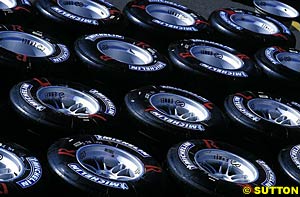 Schumacher and his supporters have left the FIA press conference and are celebrating in the lower paddock area in the Ferrari Motorhome, amidst a dense and chaotic melange of photographers, TV cameras and members of the Formula One press. Meanwhile, back in the upper paddock, the Michelin tire fitters are dismantling the tent that has been their factory on the road for the race weekend, and an informal but intense debriefing is underway on the periphery of the Michelin compound, with McLaren's David Coulthard, who had led the French Grand Prix at one point and had finished third, as the central figure.
Schumacher and his supporters have left the FIA press conference and are celebrating in the lower paddock area in the Ferrari Motorhome, amidst a dense and chaotic melange of photographers, TV cameras and members of the Formula One press. Meanwhile, back in the upper paddock, the Michelin tire fitters are dismantling the tent that has been their factory on the road for the race weekend, and an informal but intense debriefing is underway on the periphery of the Michelin compound, with McLaren's David Coulthard, who had led the French Grand Prix at one point and had finished third, as the central figure.
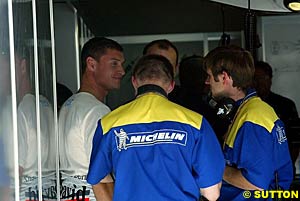 And yet on these few men and women so much depends: it has become all too obvious this season that for the literally billions of dollars spent by Formula One teams in the way of high-strung drivers and high-pitched engines to put 22 cars on the grid for a Grand Prix, ironically it is the ingredient of performance that the teams get for free - the tires - that are the key variables that provide the margin of victory.
And yet on these few men and women so much depends: it has become all too obvious this season that for the literally billions of dollars spent by Formula One teams in the way of high-strung drivers and high-pitched engines to put 22 cars on the grid for a Grand Prix, ironically it is the ingredient of performance that the teams get for free - the tires - that are the key variables that provide the margin of victory.
 How many tires are produced for a race weekend by Michelin? Each of the 12 drivers in the six Michelin-supplied teams is provided with a primary dry-weather tire as well as an option tire (the softer compound), and Michelin has to produce enough to be prepared to support whatever choice the drivers make. During Friday practice, a driver is allocated 12 tires. After the driver makes his choice between the primary and option tires for qualifying, he is limited to a further 28 tires for qualifying and the race - 7 sets of tires in all.
How many tires are produced for a race weekend by Michelin? Each of the 12 drivers in the six Michelin-supplied teams is provided with a primary dry-weather tire as well as an option tire (the softer compound), and Michelin has to produce enough to be prepared to support whatever choice the drivers make. During Friday practice, a driver is allocated 12 tires. After the driver makes his choice between the primary and option tires for qualifying, he is limited to a further 28 tires for qualifying and the race - 7 sets of tires in all.
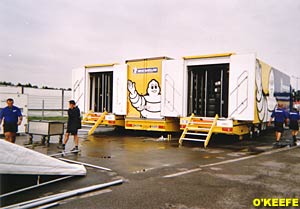 Michelin typically sends to each race 7 trucks along with 2 minivans to shuttle the crew in and around the racetrack, according to Jose Nunez - born in Clermont-Ferrand and the Michelin Competition executive, responsible for the logistics of getting everything and everyone to and from Clermont-Ferrand to the racetracks on time and in one piece. Because the French and German Grands Prix were back-to-back, the truck that converts into the popular Michelin hospitality motorhome at the races was driven straight from Magny-Cours to Hockenheim.
Michelin typically sends to each race 7 trucks along with 2 minivans to shuttle the crew in and around the racetrack, according to Jose Nunez - born in Clermont-Ferrand and the Michelin Competition executive, responsible for the logistics of getting everything and everyone to and from Clermont-Ferrand to the racetracks on time and in one piece. Because the French and German Grands Prix were back-to-back, the truck that converts into the popular Michelin hospitality motorhome at the races was driven straight from Magny-Cours to Hockenheim.
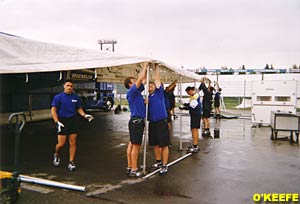 By Wednesday at 2:00 PM, the Michelin canopy in the Hockenheim paddock is in readiness for the tire fitters to mount the intermediate and rain tires for the German Grand Prix. The tires I saw in the warehouse on Monday morning are stacked all around in an orderly way, arranged in sets and marked up, ready to be assigned to the various teams. And, all the tires are the same. There are no BMW-Williams, Renault, McLaren-Mercedes or Minardi tires; nor is there a qualifying tire versus a racing tire.
By Wednesday at 2:00 PM, the Michelin canopy in the Hockenheim paddock is in readiness for the tire fitters to mount the intermediate and rain tires for the German Grand Prix. The tires I saw in the warehouse on Monday morning are stacked all around in an orderly way, arranged in sets and marked up, ready to be assigned to the various teams. And, all the tires are the same. There are no BMW-Williams, Renault, McLaren-Mercedes or Minardi tires; nor is there a qualifying tire versus a racing tire.
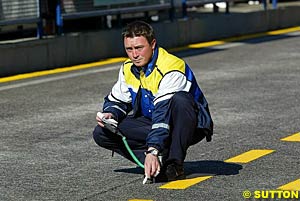 It is fascinating to see how skilled these professionals have become by race 12 of the season in getting out of each other's way. And, although the Michelin men do not change wheels or participate as mechanics, I did see several instances where a Michelin technician would helpfully complete fastening a tire warmer when the team's wheel man had rushed the job and left it undone.
It is fascinating to see how skilled these professionals have become by race 12 of the season in getting out of each other's way. And, although the Michelin men do not change wheels or participate as mechanics, I did see several instances where a Michelin technician would helpfully complete fastening a tire warmer when the team's wheel man had rushed the job and left it undone.
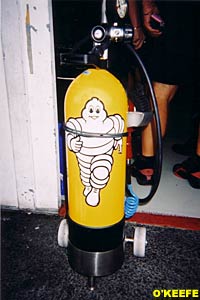 Just 50 years old this Summer, he has been in the racing tire business with Michelin for 17 years - first as a mechanics manager, then as a tire designer, then as a race technician for DTM cars and GT cars and finally, in 2000, he became Michelin's test technician for Formula One, when Michelin spent a year re-learning the ropes by going to many of the tracks with test mules that were an old Williams and an old Stewart. In all, the testing period was about 500 days and covered 100,000 kilometers.
Just 50 years old this Summer, he has been in the racing tire business with Michelin for 17 years - first as a mechanics manager, then as a tire designer, then as a race technician for DTM cars and GT cars and finally, in 2000, he became Michelin's test technician for Formula One, when Michelin spent a year re-learning the ropes by going to many of the tracks with test mules that were an old Williams and an old Stewart. In all, the testing period was about 500 days and covered 100,000 kilometers.
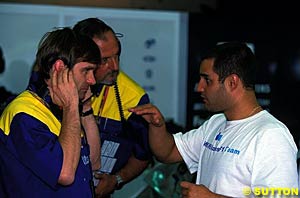 Over these first two seasons, it seems that Juan and Gilles have come to develop a close working relationship, and Juan's five consecutive pole positions and duels with Michael Schumacher and Kimi Raikkonen this season bear witness to the success of that relationship. This mutual respect has been earned and appreciated on both sides. On one occasion, Gilles recalls second-guessing the tire choice being made at the Friday meeting, and on Saturday morning after practice Juan came over and expressed himself to Gilles in Montoya's typically colorful manner: "We are fucked, because you were right yesterday."
Over these first two seasons, it seems that Juan and Gilles have come to develop a close working relationship, and Juan's five consecutive pole positions and duels with Michael Schumacher and Kimi Raikkonen this season bear witness to the success of that relationship. This mutual respect has been earned and appreciated on both sides. On one occasion, Gilles recalls second-guessing the tire choice being made at the Friday meeting, and on Saturday morning after practice Juan came over and expressed himself to Gilles in Montoya's typically colorful manner: "We are fucked, because you were right yesterday."
 Once the die has been cast after the Friday meeting as to the primary or option tire, Saturday dawns and the drivers are each given 28 tires of the specification they have chosen - 7 sets in all - and those tires must last them for the rest of the weekend.
Once the die has been cast after the Friday meeting as to the primary or option tire, Saturday dawns and the drivers are each given 28 tires of the specification they have chosen - 7 sets in all - and those tires must last them for the rest of the weekend.
 But some things don't change. David Coulthard, who finished fifth in the German Grand Prix, stopped by the Michelin compound for his informal debriefing on his way back from parc ferme, and after his debriefing, some of the Michelin engineers were engaged in an intense discussion as to how the tires performed at Hockenheim, while already discussing the preparations for the next race.
But some things don't change. David Coulthard, who finished fifth in the German Grand Prix, stopped by the Michelin compound for his informal debriefing on his way back from parc ferme, and after his debriefing, some of the Michelin engineers were engaged in an intense discussion as to how the tires performed at Hockenheim, while already discussing the preparations for the next race.
Please Contact Us for permission to republish this or any other material from Atlas F1.
|
Volume 8, Issue 33
Atlas F1 Exclusive
Chemistry Class at Clermont-Ferrand
Giancarlo Fisichella: Through the Visor
Hungarian GP Preview
The Hungarian GP Preview
Local History: Hungarian GP
Hungary Facts, Stats and Memoirs
Tech Focus: GP Racing Car Engine
Columns
The Hungarian GP Quiz
Rear View Mirror
Bookworm Critique
Elsewhere in Racing
The Grapevine
> Homepage |